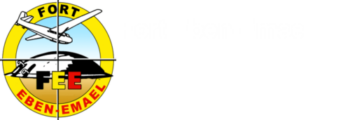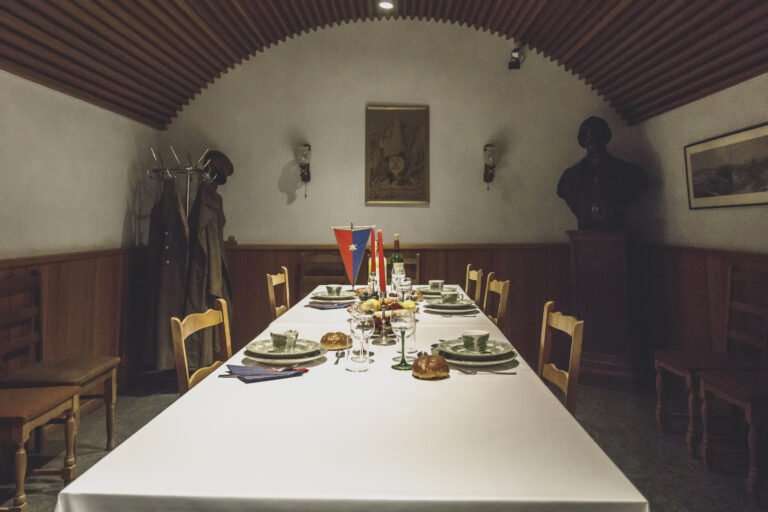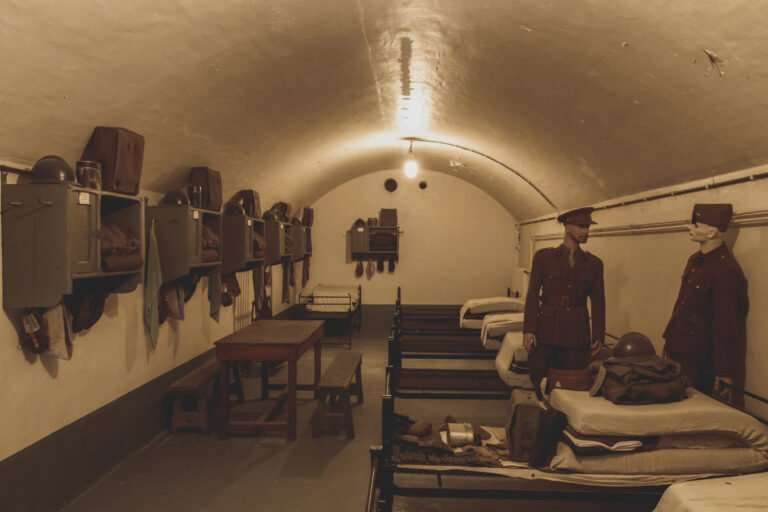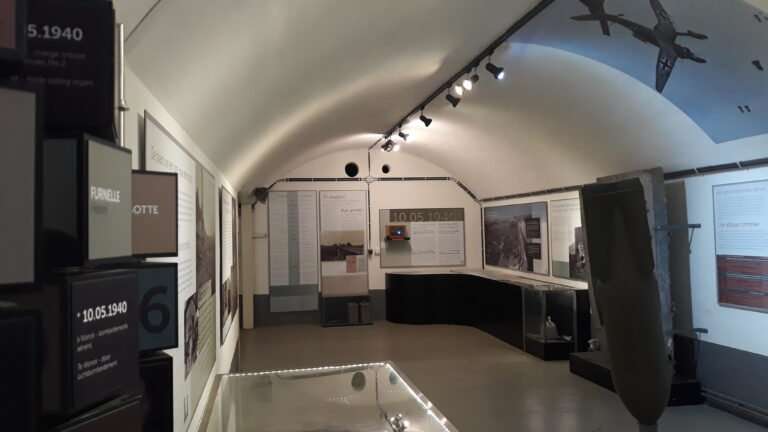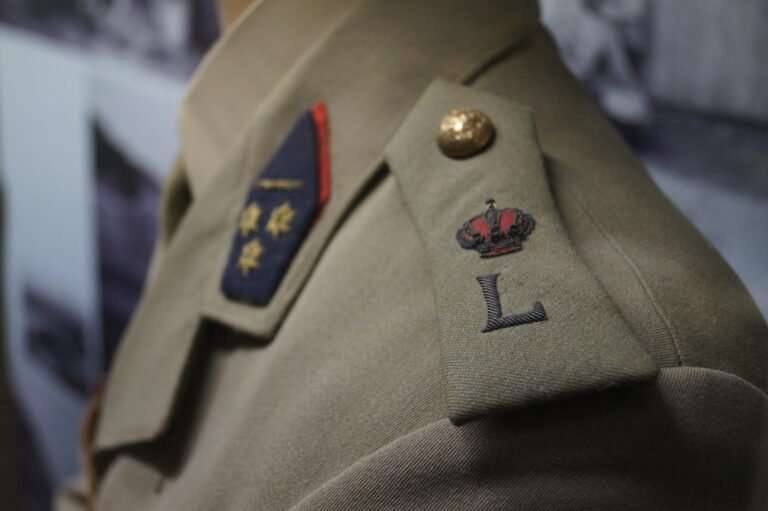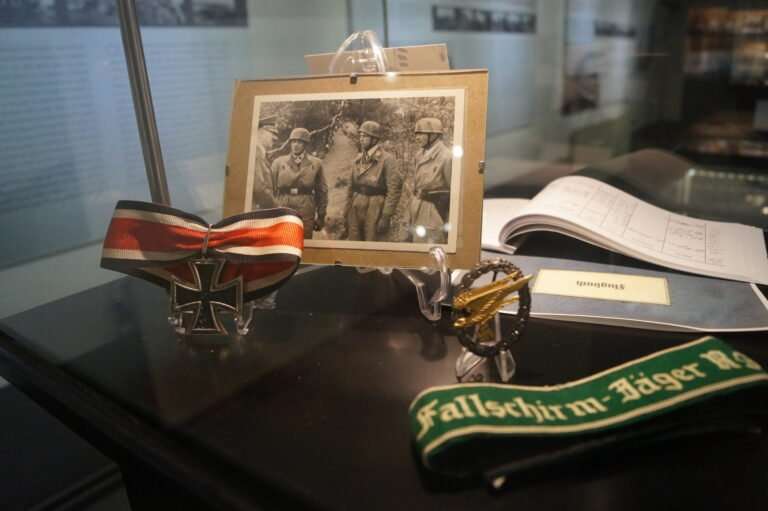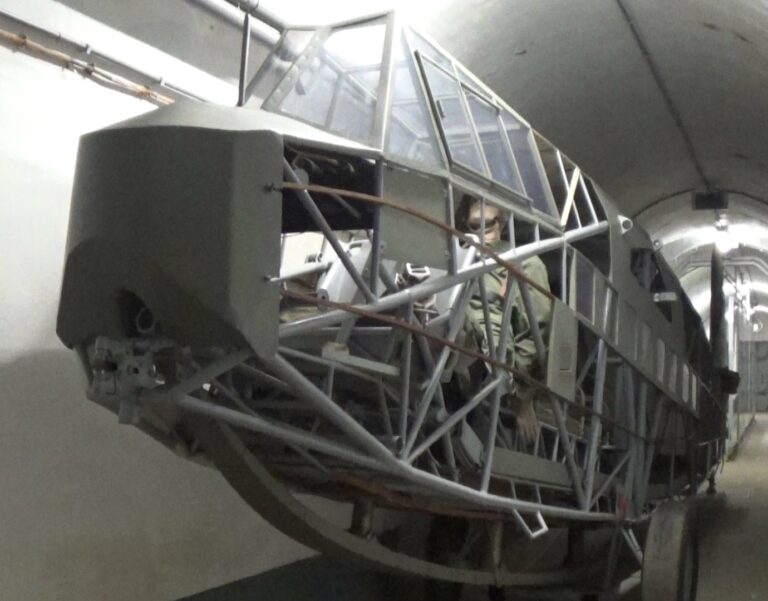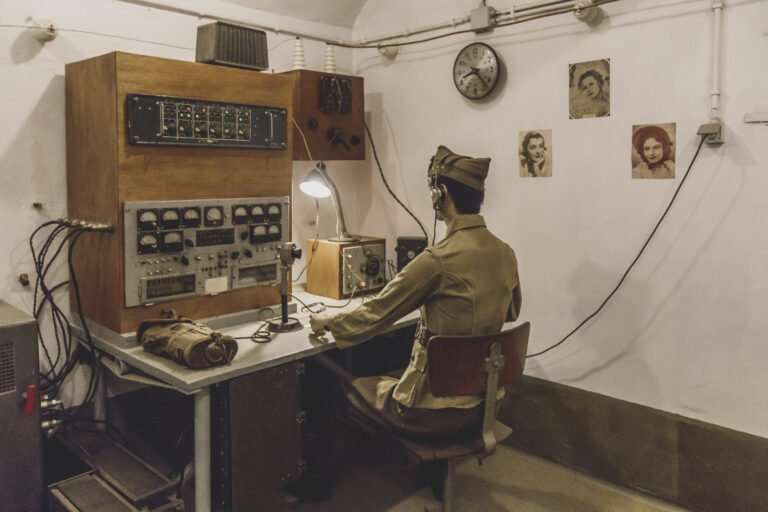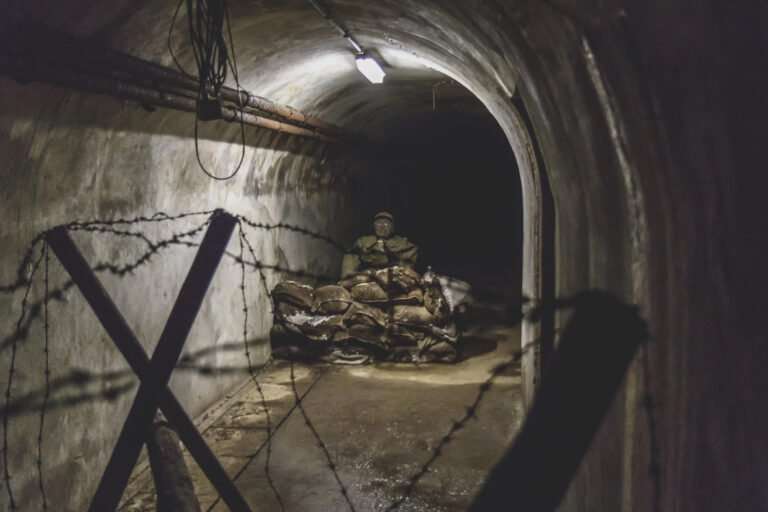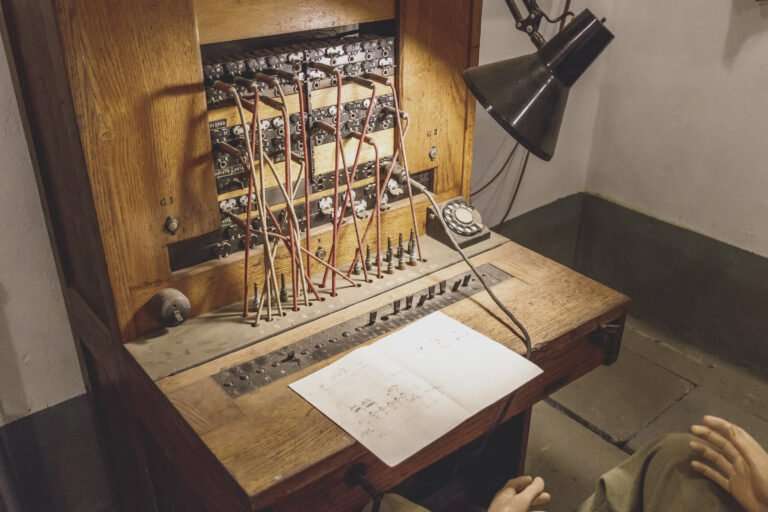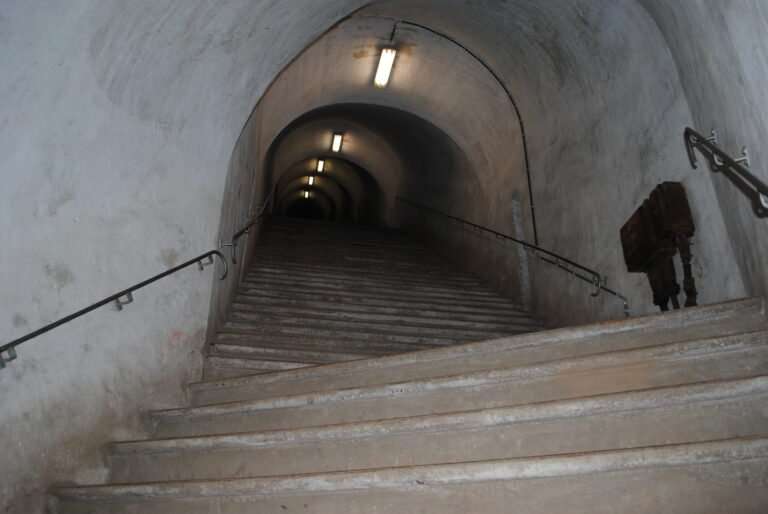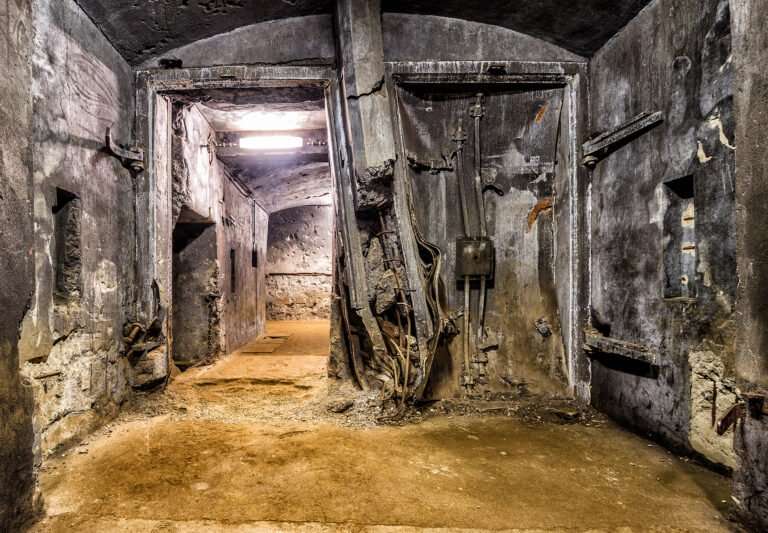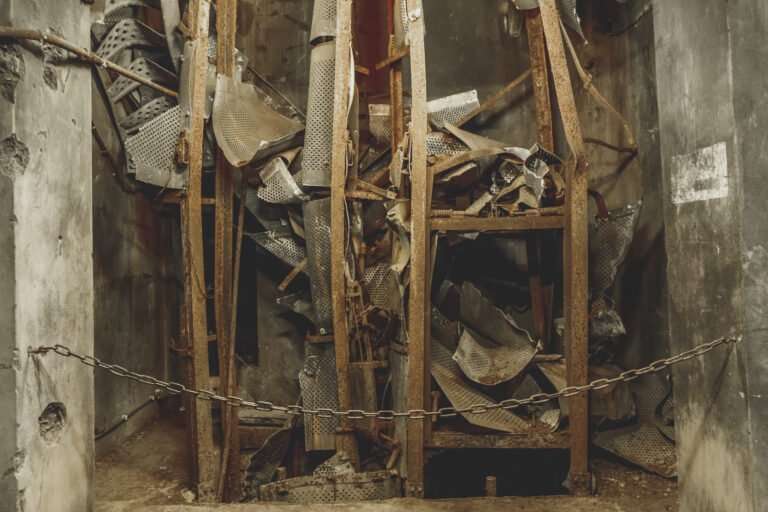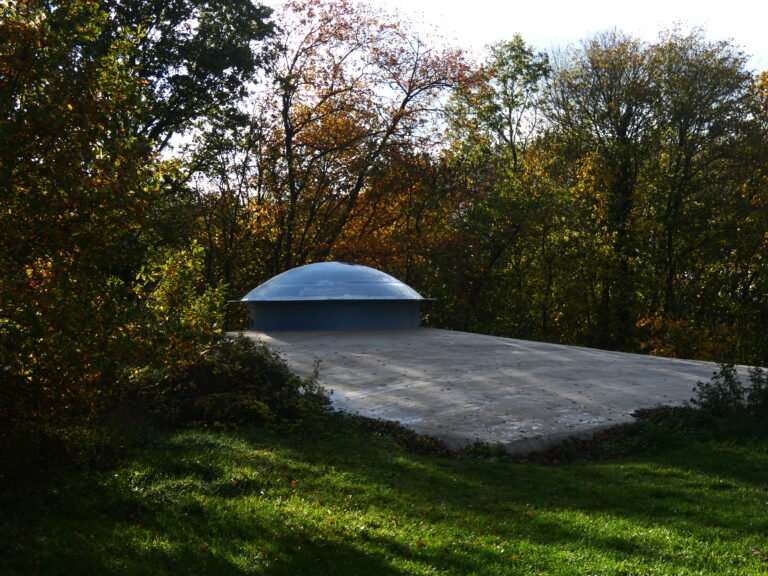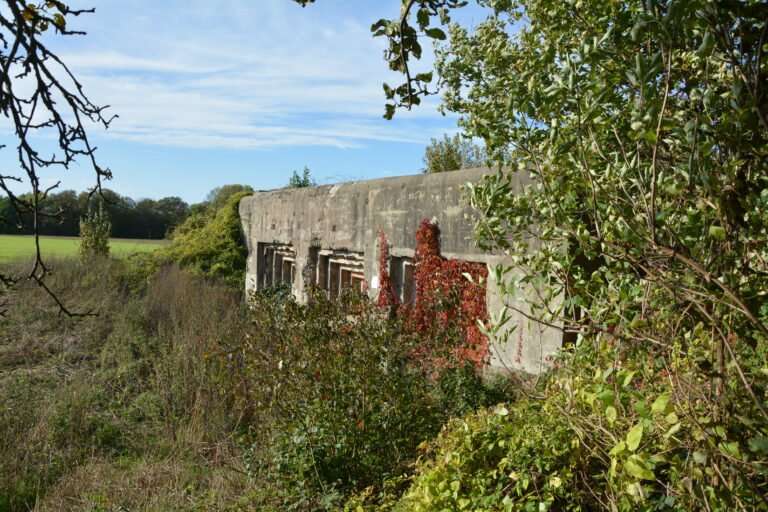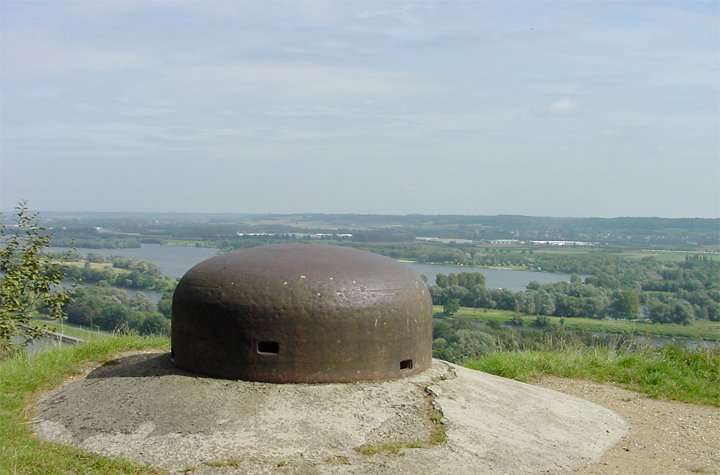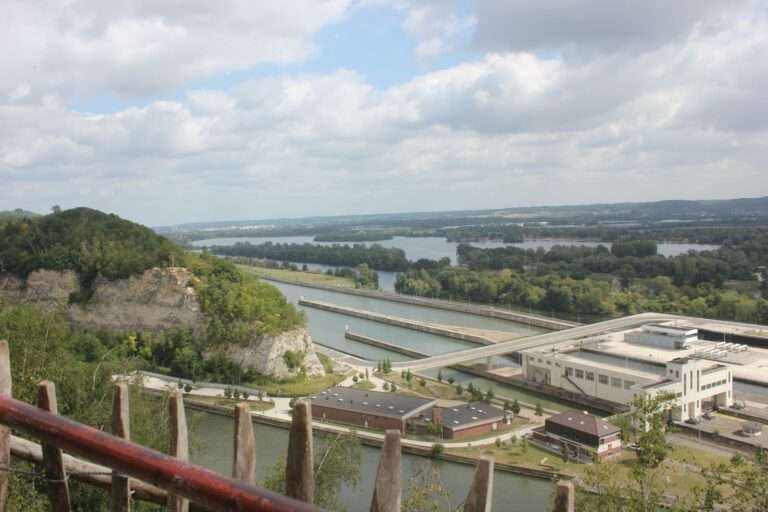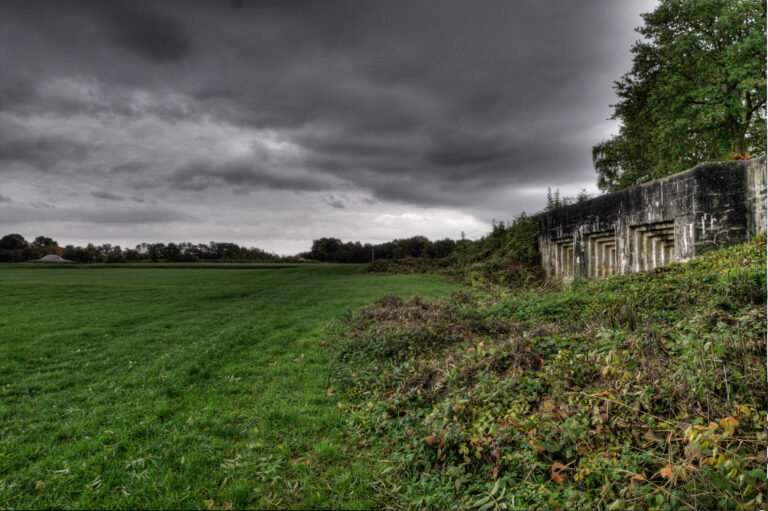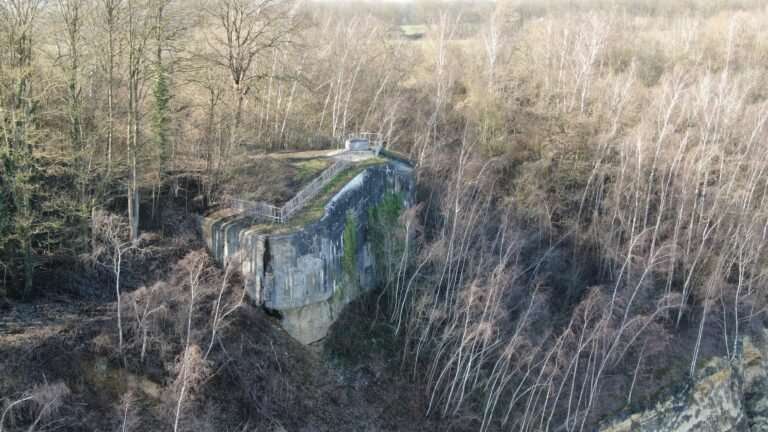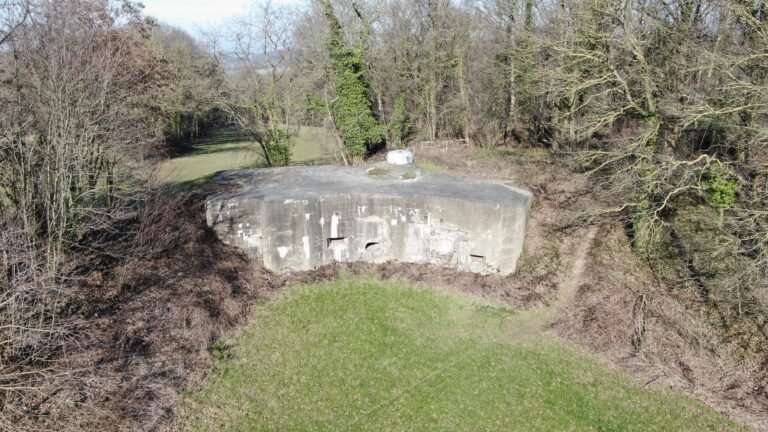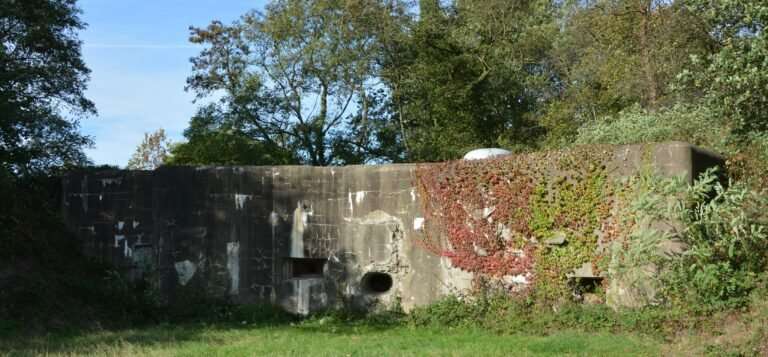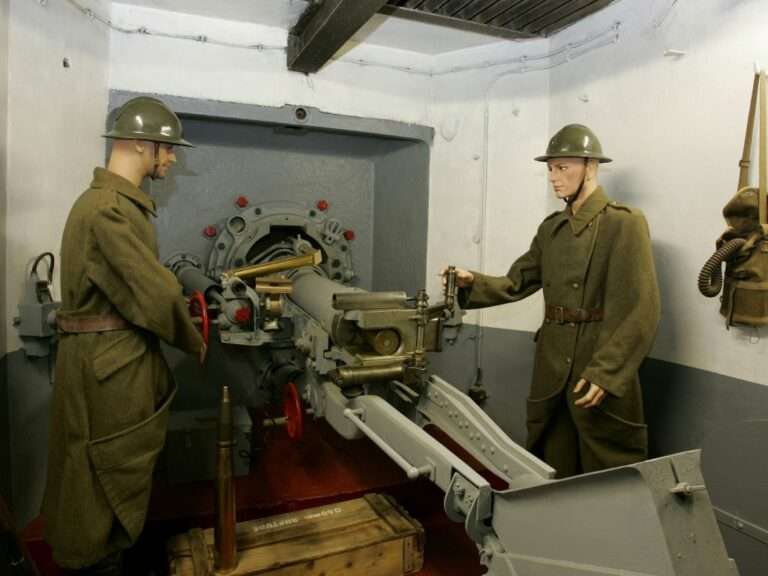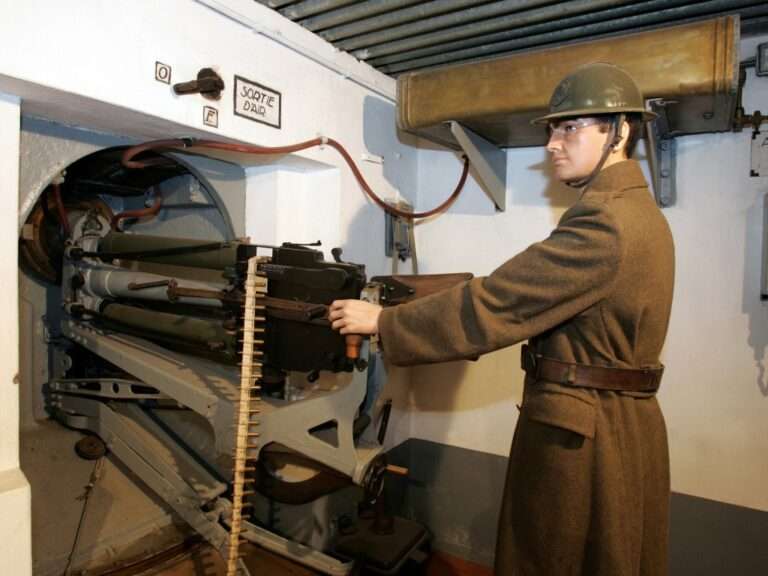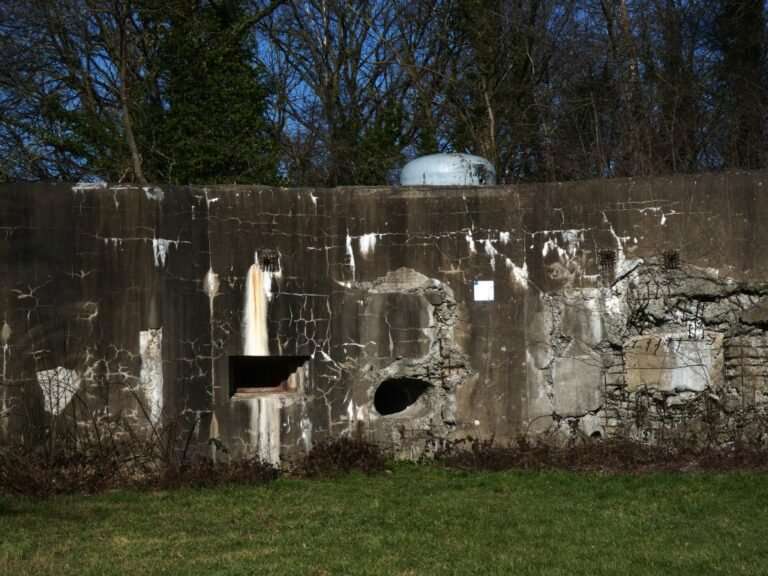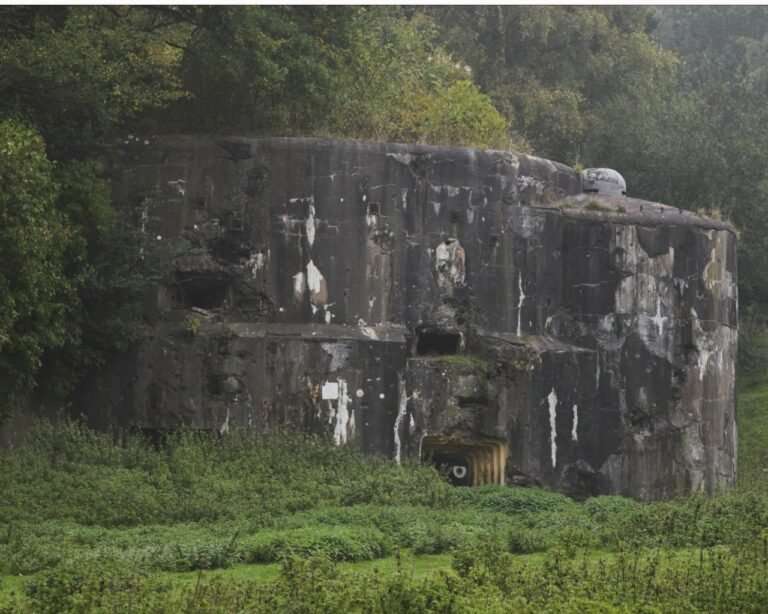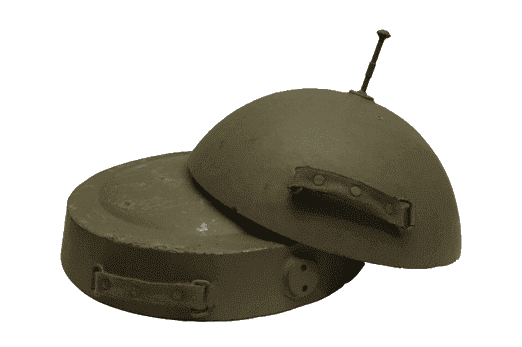Fort Eben-Emael, an immense and unique underground complex
Fort Eben-Emael is a vast military complex dug out in a marl hill between 1932 and 1935.
Its floor plan is a large triangle with a base measuring 750m and a height of 950m. The total area of the site was 75 hectares, equivalent to about 150 football pitches.
The Albert canal, with its 60m tall and almost vertical walls, forms the Eastern boundary of the fortress. The river Jeker runs to the Northwest, as well as a water-filled moat which could also be used to innundate the terrain in front of the fort’s entrance.
A dry anti-tank ditch was dug to the South. The ground defences were completed by barbed-wire fences up to 6 m wide and by anti-tank obstacles.
The fortress was built to protect the bridges over the River Meuse and the Albert canal in the Visé, Maastricht and Lanaken region and to prevent a German invasion force from using the access roads and bridges to penetrate into central Belgium.
In 1940, Fort Eben-Emael formed part of the Fortified Position of Liège together with 3 other newly built, modern forts, 8 upgraded C19th forts and a vast network of pillboxes and obstacles.
The underground barracks
Level 0 - 45m below the hill plateau
Immediately behind the tall iron gate, a wooden retractable bridge over a 3m deep pit is covered by a a machine gun embrasure and a heavy armoured door. Adjacent to the door is a personnel decontamination area. Following this, the 200m long principal gallery leads to the power plant, the workshops and the underground barracks, designed to accommodate up to 1200 soldiers in time of war. The power plant, shower area, kitchen, well pump, commandant’s office, officers’ mess, sleeping quarters for officers and nco’s and dormitories for the troops are all restored and take visitors back to the late 1930’s.
The infirmary, with its own operating theatre and sterilisation room, provided the garrison with full medical facilities.
THE MUSEUM AREA
Level 0 - 45m below the hill plateau
Located across 2 rooms of the former infirmary, the museum area is dedicated to the spectacular gliderborne attack on 10 May 1940 on the fortress and on the three bridges across the Albert canal immediately to the North.
A second area in the old soldiers’ living quarters shows you what life was like in the valley of the river Geer in 1944/45 and takes you back the horrors of the German V1 and V2 flying bombs.
THE DFS 230 GLIDER
Level 0 - 45m below the hill plateau
Only three DFS 230 (Deutsche Forschungsanstalt für Segelflug) gliders have been preserved in museums across in the world.
The DFS 230 glider on display at the Eben-Emael has been assembled mainly with parts reclaimed from the wreckage of three original gliders. The cockpit and dashboard are completely original and both come from the same aircraft. The glider was put together by former German glider pilots under the supervision of Hans Jacobs, who designed the DFS 230 was built for the Luftwaffe in 1936. Close co-operation between German and Belgian veterans allowed the DFS 230 glider to be moved to the fortress in 2008 with the support of the Belgian Ministry of Defence.
Eleven of these DFS 230 gliders carried out a surprise attack on the fortress on 10 May 1940. This was the world’s first ever airborne assault by special forces.
The galleries
Level 1 - 25m below the hill plateau
A maze of 5km of underground galleries connects the barracks to the command post, the air filtration rooms, the air vents, the ammunition stores and the 17 bunkers. These can be separated from the rest of the fort and secured by heavy armoured doors. The often sloping corridors are connected run parallel to the contours of the hill in which the fort is built. Waysigns were painted on the walls of the galleries to show the soldiers the way around this vast underground tunnel system.
Your guide will lead you through part of the well-lit galleries.
We also offer themed tours which extend into the more remote and unlit sections of the galleries.
THE EXPLOSION OF A SHAPED CHARGE IN THE GALLERIES
Level 1 - 25m below the hill plateau
In the morning of 11 May 1940, German paratroopers placed a shaped charge at the bottom of the stairwell of the Maastricht 1 casemate which they had taken the previous day. The enormous explosion caused a huge pressure wave, killing four Belgian soldiers and seriously wounding several others. This incident had even more dramatic consequences and let to the surrender of the fort later that same day.
Witness the damage and havoc caused by this novel type of explosive charge, and be moved by the dramatic story of the young soldiers of the garrison.
The Artillery bunkers
Level 2 - on the plateau
On the roof of the fortress and connected to the underground galleries by saircases and ammunition lifts are four large artillery casemates and three artillery cupolas.
Two undamaged casemates can still be visited today and each have three quickfire 75mm field guns with a maximum range of 11Km. Two artillery are also equipped with 75mm guns covering a full 360° firing arc. These cupolas have armour plating with a thickness of 33 cm.
The largest cupola is made out of a double layer of nickel-chromium steel to create armour plating with a massive thickness of 59 cm. The entire cupola, comprising both a fixed and a moving turret, weighs in at 440 tonnes. This cupola has 120 mm guns with a 360° firing arc and a range of up to 17Km.
Our range of guided tours allows visitors to discover the various bunkers types and artillery cupolas.
THE SUPERSTRUCTURE
Level 2
The superstructure of the fort is spread out on a plateau with an area of 45 hectares.
In the early morning of 10 May 1940, ten gliders landed on the fortress in total silence, taking the garrison completely by surprise.
The site is still owned by the military but is open to the public provided they stay on the waymarked paths. In 1940 there was no tall vegetation on the plateau or the escarpments.
During a tour of the superstructure, your guide will tell you all about the landing of the gliders and the attack of the German paratroopers on the Belgian positions.
A walking map of the plateau showing the location of the various bunkers is available from the fort’s museum shop.
THE DEFENSIVE BUNKERS
Level 0, 1 and 2
Seven infantry bunkers for close-quarter defense are spaced out on top of the hill and around the perimeter of the fort. In addition, the Albert canal was defenced by a further two bunkers, of which one has been demolished over time. These defensive bunkers were equipped with 60 mm anti-tank guns, machine guns, searchlights, and observation turrets. The two bunkers on the plateau were heavy machine gun bunkers, and each had three Maxim machine guns.
Some of these defensive bunkers, and the existing canal bunker, can be visited on our themed tours.
THE ATTACK
10 MAY 1940
At dawn on 10 May 1940, 10 large transport gliders carrying an elite unit of German paratroopers (codename GRANIT) landed on the roof of the fortress. There had been no official declaration of war yet.
Immediately upon landing, an attack group disabled the anti-aircraft machine gun post. Most of the observation cupolas, machine gun bunkers, artillery bunkers, and the artillery cupolas were neutralised very quickly through the use of a new type of explosive, the hollow charge.
Gliders also landed on three bridges over the Albert canal to the North of the fortress and the two major bridges were captured.
Several counterattacks by the Belgian garisson failed because of a lack of automatic weapons and suitable training. The adverse terrain and regular bombardments by the German Luftwaffe ensured that the German attackers kept the upper hand.
Artillery fire from Fort Pontisse and Fort Barchon in Liège was ineffective as the German soldiers took cover in the bunkers they had already conquered.
During the night of 10 to 11 May 1940, German ground forces crossed the Albert canal and surrounded the fortress.
By shortly before midday on 11 May 1940, only two artillery bunkers were still operational and defensive fire was impossible because the observation posts had been neutralised. The defending forces’ situation had become critical. The destructive effect of the new German explosives had wrecked the morale of the garrison. Many soldiers in the garrison were either dead, seriously wounded, or demoralised.
The defenders called a ceasefire and around noon on Saturday 11 May 1940 and the fortress surrendered. Eben-Emael had been taken by the enemy.
THE SHAPED CHARGE
A shaped charge is an explosive device, but unlike traditional charges, the full power of the explosive is concentrated in the hollow section in the middle of the bomb. The German attackers used to types, weighting 12.5 and 50Kg respectively.
A 50Kg shaped charge can penetrate 20 to 25cm of steel and 35cm of concrete. A vast quantity of concentrated gas is released during the explosion to reach a temperature of around 2800° Celsius. This creates a pressure wave that destroys and pulverises all the material underneath.
The functional principle had been described as early as the late C18th, but wasn’t applied as a usable weapon until the late 1930s. (Munroe effect, 1888. First use in 1792).
The attack on Fort Eben-Emael was the first time this new weapon had been used in combat.
THE EFFECT OF THE ATTACK
The German attack succeeded on various levels.
Not only did the assault break through the Belgian positions on the Albert canal but it also delivered a psychological blow to the Belgians and the Allies and gave the Germans a huge morale boost: the strongest fortress in Europe had been taken in little or no time.!
The breakthrough also had a much wider strategic effect.
As planned by German high command, French and British troops moved forward into central Belgium, clearing the way for the high-speed German thrust through the Ardennes.
The result is well-known: allied troops were surrounded in Belgium and the British and French were pushed back to Dunkirk and Calais.
